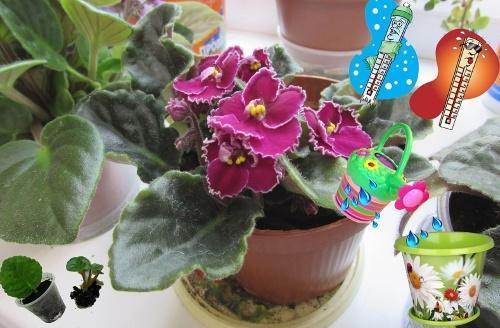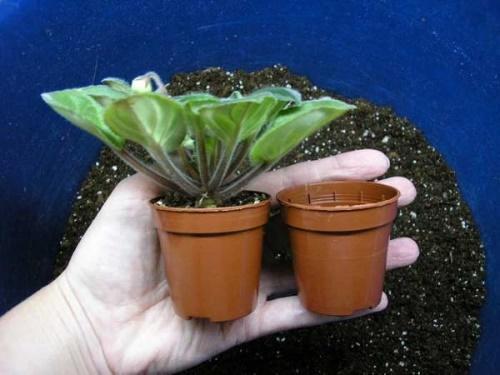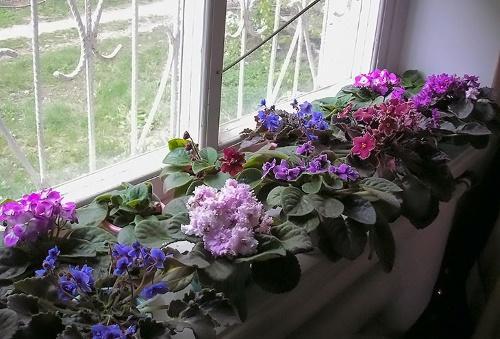Competent care is the key to the lush bloom of violets or how to please hairy beauties
 Blue and purple, red and burgundy, white and pink, small simple and large terry - the variety of indoor violets simply scatters eyes, but the choice of any one plant seems to be an impossible task. I just want to buy everyone, but, unfortunately, the room space is not dimensionless, and good varietal species are not cheap. So we tremble over our pet, who was lucky enough to get into the home collection, trying to please her in order to get a gorgeous flowering in return. How to care for violets, because these ladies have a capricious character, and react to any violation of the regime quickly and negatively?
Blue and purple, red and burgundy, white and pink, small simple and large terry - the variety of indoor violets simply scatters eyes, but the choice of any one plant seems to be an impossible task. I just want to buy everyone, but, unfortunately, the room space is not dimensionless, and good varietal species are not cheap. So we tremble over our pet, who was lucky enough to get into the home collection, trying to please her in order to get a gorgeous flowering in return. How to care for violets, because these ladies have a capricious character, and react to any violation of the regime quickly and negatively?
To capricious "bloom and smelled", you need to take care of the following nuances:
- choose the right pot and soil mixture for them;
- choose a suitable place for flowers in the house:
- provide sufficient lighting and a comfortable temperature regime;
- water the bush correctly and on time;
- take care of plant feeding.
Read also the article:violets - how to care to bloom?
What should be the earth and the flowerpot for violets?
Violets have delicate roots, so the soil for them must be loose so that water and air pass through well. Ordinary garden soil does not suit them, it is too heavy and dense, does not breathe and dries out for a long time. In such soil, the roots will quickly rot and the flower will disappear.
The best option is to purchase ready-made soil mixtures specifically for violets. They are in any flower shop, have a loose structure and already contain the nutrients necessary for flowers, which will be enough for the first time.
As for the flowerpot, a small pot for violets should be chosen, otherwise the bush will actively grow leaves, but flowering will have to wait for several years. The material from which the flowerpot is made is not so important, the main thing is that there are drainage holes at the bottom.
Where to put the violet?
Lighting plays a major role in plant development. With a lack of it, the leaves stretch out, and the bush falls apart, so in a dark place you will need to install additional lighting lamps. Excess light is also harmful and fraught with the loss of delicate leaf plates of their color (especially for varieties with solid dark green leaves), and even threatens burns. In this case, the flower needs to be shaded.
On the eastern windowsill, the violet will be light and comfortable, while the window should not open, because it is afraid of the draft.
 Violets grow well at temperatures between 20 and 24 degrees Celsius. In winter, a slight drop to 18 degrees is permissible, but no more, otherwise they will freeze.
Violets grow well at temperatures between 20 and 24 degrees Celsius. In winter, a slight drop to 18 degrees is permissible, but no more, otherwise they will freeze.
How to water and feed?
Light soil dries out quickly enough and you need to monitor this by setting up regular watering and not allowing it to dry out completely, but be careful not to frequent it so that the violet does not rot.
To water bush in several ways:
- through the pallet;
- by immersing the pot in water;
- using wick irrigation.
It is also possible to pour water directly into the pot, but not desirable - there is a risk that the drops will fall into the outlet, and the violet does not like this.
Despite the fact that violets prefer good air humidity, it is not recommended to spray fluffy leaves. It is better to place a glass of water next to it.
Like any richly flowering plant, the violet needs good nutrition. To do this, you need to use complex liquid preparations specifically for violets, making them twice a month in the spring-autumn period.
Having paid a little attention to the violets, in gratitude we get a lush rosette of beautiful shaggy leaves and a fascinating flowering, and with proper care - also young bushes that can be shared with friends.